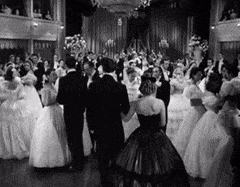Yesterday a dear friend and reader drew Etiquetteer’s attention to a New York Times “Ask Vanessa” column about getting around a dress code. The woman writing discovered that it was required to wear pastels to an event, and she didn’t look good in pastels. But the way she posed the question was objectionable: “…do I really have to obey? Is there anything we can do about hosts imposing a requirement on guests?” Those pesky hosts! Just wanting to show us a good time in a certain way!
Eventually Vanessa Friedman provided some good fashion advice (choose gray or cream, highlight a darker outfit with an accessory). Etiquetteer would suggest a corsage of fresh flowers — why not? But in the Comments section* comes the advice Etiquetteer really recommends: if you don’t like the dress code, don’t go. Just don’t go! Send a Lovely Note of Regret and be done with it. Should the hosts beg you to come, remain steadfast and mysterious, or tell them you don’t like the dress code on the invitation and prepare for a Discussion About Feelings.
Ms. Friedman does call out the difference between a dress code, which indicates a degree of formality (e.g. formal, informal, business casual, costume, etc.) vs. a theme, often a color. A dress code “does help ameliorate guests’ confusion and insecurity about what to wear to a special event,” she writes, and she’s right. A theme, like a color, should not be thought of as a restriction, but as a framework for creativity. That’s what makes party-giving, and partygoing, fun. Etiquetteer has never forgotten a small dinner in high school to which everyone invited was instructed to wear something beginning with the letter I. We saw everything from Inverness capes to a tiny lightbulb strapped to someone’s wrist to represent an idea. What could be more Perfectly Proper?
The Anti-Elitist Killjoys in the Comments section, however, are having none of it! They just don’t like being told what to wear at all, and are proud of it. One commenter suggested that the hosts had “delusions of grandeur” for commanding people to dress in a certain way**. Etiquetteer can only laugh at these assumptions. Let These People stay home with Dorothy Draper’s “Will to be Dreary.”
A party is designed to be fun! And sometimes hosts add a theme to contribute a visual impact to that sense of fun. The column includes a photo of the famous Diner en Blanc, an event which makes such a fabulous impression because everyone obeys the dress code. It was the same for Truman Capote’s famous Black and White Ball of 1966. Years ago Etiquetteer attended a different White Party, the dress code for which was historically “Cool resourceful white.” One frivolous young man felt that Simply Would Not Do, showed up in some sort of colorful print . . . and was turned away at the door, quite rightly. This is akin to Bette Davis in Jezebel deliberately wearing a red ball gown to an all-white party, and we know what happened to her.
Ultimately you don’t want to look like you didn’t get the memo, like that Kimberly Guilfoyle at Tiffany Trump’s wedding, wearing what could be either black or navy blue with all the Trump women in pastels***. Long story short, if you don’t (or can’t) accommodate the dress code, for whatever reason, decline without sanctimony and enjoy your evening at home.
Bette Davis receiving everyone’s backs in Jezebel.
*So often the Comments section of any news article should be avoided, but not this time.
**That said, the term bridezilla exists for a reason . . .
***Etiquetteer has no idea what dress code information was (or was not) shared with any of the wedding guests.


